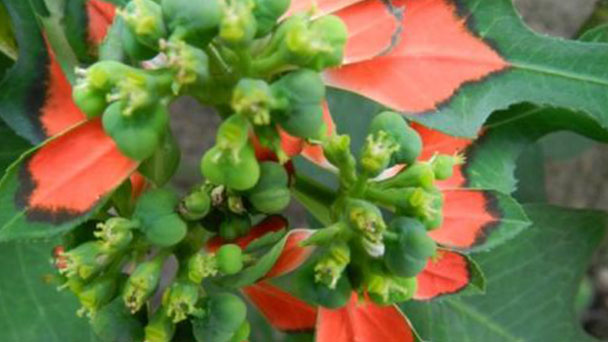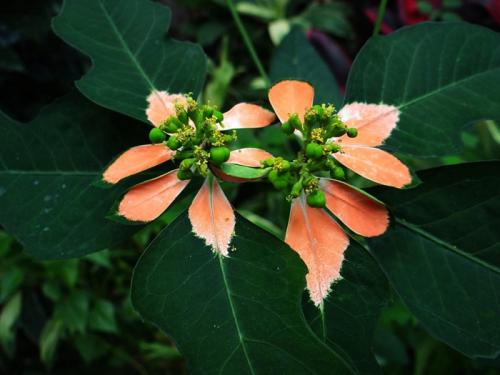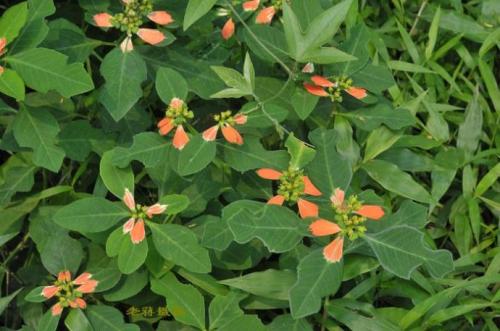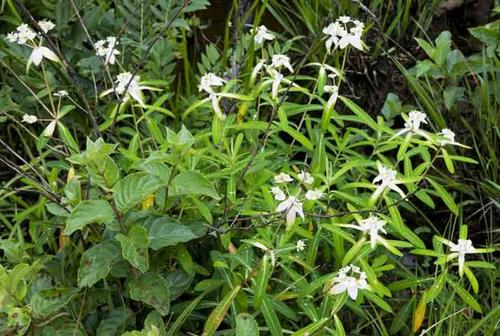Euphorbia heberophylla (Mexican fireplant) profile
Written by Maggie
Mar 25 2021

Euphorbia heterophylla, commonly known as fireplant, painted euphorbia, Japanese poinsettia, desert poinsettia, wild poinsettia, fire on the mountain, painted leaf, painted spurge, milkweed, and kaliko plant, is native to tropical America. Euphorbia heterophylla likes a warm and dry and sunny environment, not cold, frost, resistance to half shade, afraid of water, appropriate in loose fertile and good drainage of the decay of the soil growth. Euphorbia heterophylla is an evergreen or semi-evergreen shrub, 0.5 ~ 2 m in height when potted, grows to more than 6 m in subtropical areas.
Euphorbia heberophylla picture

Morphological characteristics of Euphorbia heberophylla
Shape
Euphorbia heterophylla is an annual or perennial herb. Roots are terete, 30 -- 50 cm long, 2 -- 7 mm in diameter, base sometimes lignified. Stem is erect, distally much branched, up to 1 m tall, 3 -- 8 mm in diameter, glabrous.
Leaf
Leaves OF Euphorbia heterophylla are alternate, ovate, elliptic or ovate-elliptic, apex acute or rounded, base tapered, 3-10 cm long, 1-5 cm wide, margin undulate or dentate or entire, glabrous; Petiole is 1 -- 3 cm long;Involucral leaves are homomorphic to cauline leaves, smaller, 2 -- 5 cm long and 1 -- 2 cm wide, reddish or only reddish at base.
Flowers
The inflorescence of Euphorbia heterophylla is solitary, several cymbals arranged on top of branches, involucre campanulate, green, 5-6 mm high, 3-5 mm in diameter, margin 5-lobed, lobes triangular, often dentate; Gland body often 1, occasionally 2, flat cup, nearly two labial, yellow. Euphorbia heterophylla has many male flowers, often out of involucre; Female flowers 1, ovary stalks clearly protruding from involucre; Ovary is trigonal globose, smooth glabrous; Euphorbia heterophylla has 3 style, detached; Capsule, trigonal, 4. 5 -- 5 mm long, 3.5 -- 4.0 mm in diameter, glabrous.
Fruit
Seeds of Euphorbia heterophylla are ovate-elliptic, 2.5-3.0 mm long, 2-2.5 mm in diameter, brown to black, with irregular small projections;
Ecological habits of Euphorbia heberophylla
Euphorbia heterophylla is xerophytic, not cold tolerant and fond of light. Euphorbia heterophylla is dry and wet resistant. Red leaves appear in autumn.
Euphorbia heterophylla is fond of warm, dry and sunny environments, not cold, resistant to frost, tolerant to semi-shade, afraid of water, and suitable for growing in loose, fertile and well-drained rot soil.
Cultivation of Euphorbia heterophylla
Euphorbia heterophylla seedlings with 2 to 3 true leaves time seedlings l times, planted or potted at about 15 cm high in 6 months. Fertilizer was applied 1 times every half month during the growing period, and phosphorus and potassium fertilizer were added 1 time when the upper leaves showed red and white markings. Seeds are easy to crack when they are mature, so seeds should be picked in time.
Roots of Euphorbia heterophylla were sensitive to water, temperature, oxygen and fertilizer concentration. The basin soil is usually used garden soil plus leaf rot soil and compost soil. The general mixing ratio is garden soil 2, leaf rot soil 1 and compost soil 1. Cutting seedlings on the pot after shading 5 ~ 7 days to give sufficient sunshine. After 3 to 4 weeks of growth, the core can be plucked. Count up from the base and leave 4 to 5 leaves. Cut off the branches of Euphorbia heterophylla so that they give out 3 to 4 lateral branches to form a plant with 3 to 5 flower heads.
Summer watering every morning and evening once a day, as the temperature drops, the number of watering should be appropriately reduced.Generally appropriate basin soil to see dry after pouring. Watering should be carried out before noon, afternoon watering will make the soil temperature drop, adverse plant growth, and every watering requirement thoroughly.
Euphorbia heterophylla was fond of fertilizer, and the growth of Euphorbia heterophylla mainly needed more nitrogen fertilizer, and the lower part of Euphorbia heterophylla would fall off due to the lack of nitrogen fertilizer. In addition to the application of sufficient base fertilizer, 7 ~ 10 days after the heart, that is, should start topdressing, once a week. Topdressing is appropriate to light, avoid the application of concentrated fertilizer, fertilizer can be cooked cake fertilizer water, etc.Water solution such as calcium superphosphate is applied near the time of flowering to make bracts bright in color.
Euphorbia heterophylla grows strongly and is often overgrown under normal management, which is detrimental to ornamental value when planted in pots. In general, the internodes of Euphorbia heterophylla could be shortened and the plant dwarfed by 0.5% B9 watering pot soil or 1500ppm ~ 3000PPm CCC spraying on leaf surface. Paclobutrazol (PP333) was also used to spray the cloth with good results. The concentration is generally 200PPm ~ 300PPm.
When the temperature drops in autumn and winter, people need to move Euphorbia heterophylla into the room in late autumn. At night, the room temperature is kept at about 15 C. After flowering, the room temperature is lowered to about 12 C, which can extend the viewing time.
In family culture of Euphorbia heterophylla, it was often difficult to blossom or not to flower after autumn because the light and temperature could not meet the need of its growth. To make it bloom early in natural temperatures, it can be done by controlling the length of the day. The specific method is as follows: Starting from late August, shading starts at 6 p.m. and opens at 8 p.m. the next day. We will get 10 hours of natural light every day, and then shorten the light to 9 hours after half a month. In this way, after shading treatment for 35 to 45 days, we can flower.

Cutting propagation of Euphorbia heterophylla
Euphorbia heterophylla is often propagated by sowing. Spring sowing in spring, 7-10 days after sowing, germinate quickly and neatly. Seeds have the ability to self-sow and reproduce.
After the flowering of Euphorbia heterophylla, it entered a semi-dormant state. To cut the cuttings, place the plants in a temperature of 2C to 3C and keep them properly dry. In spring, increase the temperature and watering, break dormancy, and take out the plant, remove part of the old roots and pot soil, for fertile new soil, water enough, placed in a higher temperature room, to promote germination and growth. 4 ~ 5 months can be cut. Cuttage period, decided in the cultivation purpose, if as a cut flower cultivation, cutting period should be earlier than potted viewers. Potted cuttings in summer are more appropriate, because of premature cuttings, long growth period, long branches, high plants, and reduced ornamental value.
Matrix can be generally used vermiculite, perlite, pure river sand or garden soil Gaza. Pour enough water for the first time after the insertion, and then water should not be too much. Water can be sprayed 1 ~ 2 times a day on the leaf surface, and pay attention to shading and appropriate ventilation. Too much water, high temperature and lack of air circulation are the main reasons for the base rot of cuttings. Rooting began one week after transplantation at 15 C to 20C, and transplantation was possible 3 to 4 weeks later.
Disease & pest control of Euphorbia heterophylla
Disease
Gray mould, leaf spot and rust often occur, the first two can be sprayed with the same amount of Bordeaux liquid, rust with 50% rust ling wettable powder 20O times the liquid spray wine.
Insect pests
Insect pest has aphid and medium bald insect harm, kill with 50% borer pine emulsion 2000 times liquid spray kill.
The distribution area of Euphorbia heterophylla
Euphorbia heterophylla originated in Central and South America and naturalized in the Old World.Widely cultivated in most provinces and cities in China, commonly found in parks, botanical gardens and greenhouses, for ornamental.
Euphorbia heterophylla is widely distributed in China and cultivated in most provinces and cities of China. It is commonly found in parks, botanical gardens and greenhouses for ornamental use. Euphorbia heterophylla is grown everywhere in China.
Euphorbia heterophylla is native to Central and South America.
Euphorbia heterophylla uses
Medicinal effect
Euphorbia heterophylla tastes bitter, astringent, cold, poisonous. Euphorbia heterophylla can regulate menstruation and hemostasis, relieving bone swelling and relieving cough. Euphorbia heterophylla can treat chronic bronchitis, injury, trauma bleeding, fracture.
Garden use of Euphorbia heberophylla
Euphorbia heterophylla is a summer flower. It can be planted in flower beds, on the edge of trees or on street green Spaces; Euphorbia heterophylla can also be used as a potted flower or flower arrangement.

Latest Updated
- Benefits of Bugleweed - 7 Science-backed Health Benefits
- Bugleweed Dangers & Side Effects - Is It Poisonous?
- How to Plant Evergreen Trees - What You Should Know
- When to Plant Evergreens - Grow Guide for Evergreen Trees
- 12 Wonderful Evergreen Shrubs for Your Garden
- 12 Popular Evergreen Plants with Pictures for Beginners
- When And How To Prune A Lilac Bush Like a Pro
- How to Grow & Care for Lilac Vine (Hardenbergia Violacea)
- Japanese Lilac Tree (Syringa Reticulata) Care & Propagation Guide
- Shumard Oak Pros and Cons - What to Know
Popular Articles
- Winter maintenance of Antirrhinum Majus
- How to Grow Terminalia Mantaly Tree
- How to Grow and Care for Crossostephium Chinense
- How to grow Antirrhinum Majus in spring
- Peristeria Elata (Dove Orchid) Profile: Info & Care Guide
- Underwatered Snake Plant (Sansevieria Trifasciata) - Signs And How To Fix
- How to Care for Brazilian Jasmine Plant (Mandevilla Sanderi)
- How to Grow & Care for Graptopetalum Purple Delight in Summer
- Rosa Chinensis (China Rose): Plant Growing & Care Tips
- How to Care for Baby Sun Rose (Aptenia Cordifolia)